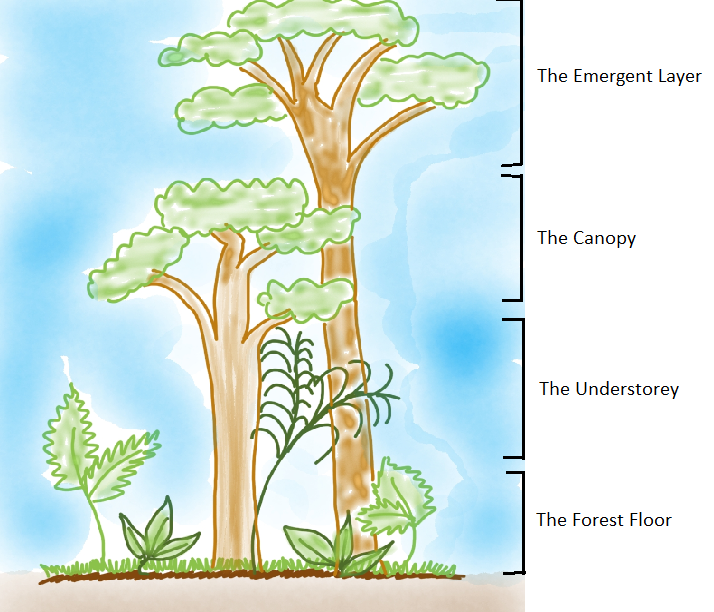
Which of the forest layer shown in the diagram receives the maximum sunlight?

A. Emergent layer
B. Canopy layer
C. Understory layer
D. None of the above

Answer
552k+ views
Hint:Sunlight is necessary for the plants because sunlight helps plants for performing photosynthesis by activating chloroplasts. However, different plants have different requirements for sunlight energy.
Complete answer:There is an uneven distribution of plants in a forest, this is known as stratification. Due to which different plants receive different amounts of sunlight.
Emergent layer: It is the topmost layer of forest. It consists of the top of trees that emerges from the canopy. These plants require the maximum amount of sunlight, therefore they emerge to receive the maximum possible amount of sunlight. Only the strongest and tallest plants are able to reach this level.
Canopy layer: It is the second layer of the forest. It is found at a lower level than the emergent layer. The canopy also receives a very good amount of sunlight. Usually, the plants which require moderate amounts of sunlight reach this level. The canopy forms a very thick and dense cover outside the forest. It filters the sunlight reaching the lower levels.
Understory layer: This layer is found below the canopy layer. It consists of various forms of shrubs. These plants require fair amounts of sunlight. The plants at this level receive filtered amounts of sunlight. The light is filtered by the canopy.
Thus, based on the above information this can be concluded that the emergent forest layer shown in the diagram receives maximum sunlight.
Hence, the correct answer is option (A).
Note: Stratification is the vertical distribution of different species that occupy different levels. Stratification is the structure in the form of a recognizable pattern in any spatial arrangement of the members of communities. Stratification is generally observed for the forest ecosystems.
Complete answer:There is an uneven distribution of plants in a forest, this is known as stratification. Due to which different plants receive different amounts of sunlight.
Emergent layer: It is the topmost layer of forest. It consists of the top of trees that emerges from the canopy. These plants require the maximum amount of sunlight, therefore they emerge to receive the maximum possible amount of sunlight. Only the strongest and tallest plants are able to reach this level.
Canopy layer: It is the second layer of the forest. It is found at a lower level than the emergent layer. The canopy also receives a very good amount of sunlight. Usually, the plants which require moderate amounts of sunlight reach this level. The canopy forms a very thick and dense cover outside the forest. It filters the sunlight reaching the lower levels.
Understory layer: This layer is found below the canopy layer. It consists of various forms of shrubs. These plants require fair amounts of sunlight. The plants at this level receive filtered amounts of sunlight. The light is filtered by the canopy.
Thus, based on the above information this can be concluded that the emergent forest layer shown in the diagram receives maximum sunlight.
Hence, the correct answer is option (A).
Note: Stratification is the vertical distribution of different species that occupy different levels. Stratification is the structure in the form of a recognizable pattern in any spatial arrangement of the members of communities. Stratification is generally observed for the forest ecosystems.
Recently Updated Pages
Master Class 10 General Knowledge: Engaging Questions & Answers for Success

Master Class 10 Computer Science: Engaging Questions & Answers for Success

Master Class 10 English: Engaging Questions & Answers for Success

Master Class 10 Social Science: Engaging Questions & Answers for Success

Master Class 10 Maths: Engaging Questions & Answers for Success

Master Class 10 Science: Engaging Questions & Answers for Success

Trending doubts
The shortest day of the year in India

Why is there a time difference of about 5 hours between class 10 social science CBSE

Write a letter to the principal requesting him to grant class 10 english CBSE

What is the median of the first 10 natural numbers class 10 maths CBSE

The Equation xxx + 2 is Satisfied when x is Equal to Class 10 Maths

State and prove converse of BPT Basic Proportionality class 10 maths CBSE




